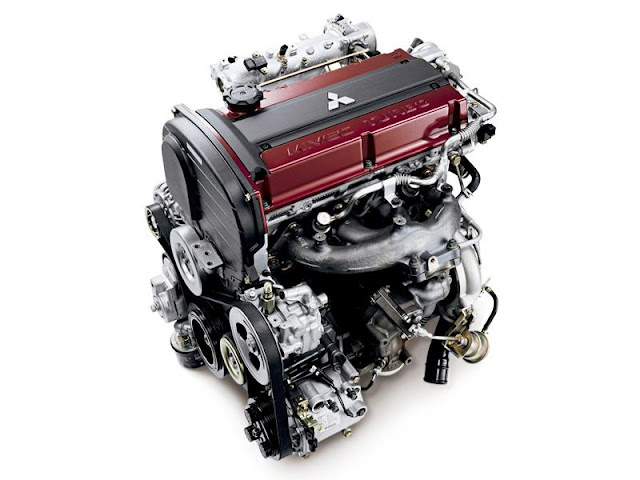The legendary 4G63T from Mitsubishi
Mitsubishi 4G63T Engine The two liter, turbocharged variant of 4G6 Series is probably the best known Mitsubishi engine ever produced. 4G63T or generally referred as 4G63 was introduced in 1988 with JDM Galant VR-4. The cast iron block was housing 4 cylinders and 1997cc displacement was achieved by 85 mm bore x 88 mm stroke. The head was featuring Dual Over Head Cams and 4 valves per cylinder. TD05H-14G turbocharger was coupled with a front-mount air-to-air intercooler.
This first version had a compression ratio of 7.5:1 and was delivering 200hp at 6000RPM. Mitsubishi continued to use it in Galant VR-4 until 1992 with minor changes. The final version of 4G63T used in Galant VR-4 was rated at 240hp thanks to a slightly bigger turbocharger.
4G63T was used in different Mitsubishi models until 2006 but it is best known for powering the mighty Lancer Evolution series all the way through Lancer Evolution I to Lancer Evolution IX. Mitsubishi engineers continued to develop 4G63T engine along with Evolution models however basic design of the engine did not change at all. 4G63T engines used in Lancer Evolution models can be divided into three generations. Mitsubishi 4G63 Engine
First Generation
First Generation 4G63T engines were used in Evo I, Evo II and Evo III models. First generation 4G63T engines had reworked intake/exhaust ports, new injectors, a bigger air-to-air intercooler, lighter connection rods and bigger turbochargers. Compression ratio was raised to 8.5:1 for 4G63s used in Evo I and Evo II models. The outputs were 245 hp and 255 hp respectively. 4G63Ts found in Evo III models were using a bigger turbocharger and had a higher compression ratio -9.0:1- compared to previous 1st generation engines thus the output was raised to 265hp.
Second Generation
Second generation 4G63T were used to power Evo IV, Evo V and Evo VI models. The major change for the second generation was the change in the cam drive system. The cam drive was moved left side and the flywheel was moved to right side of the engine bay. This configuration was the opposite of what was found in first generation engines. Second generation engines had lightweight pistons with 8.8:1 compression ratio. Intake and exhaust manifold were also revised for enhanced airflow in and out of the engine. In order reduce turbo lag a secondary air injection system was also introduced. Along with all these modfications, a twin scroll TD05 turbocharger was also used in Evo IV.
4G63T was now making 280hp. 4G63T used in Evo V was almost the same with the one found in Evo IV except the turbocharger which was slightly larger. 4G63T recieved some updates with the release of Evo VI in order to improve engine reliability. These updates were generally focused on engine cooling. Cooling channels were added to the pistons, the coolant passage layout was revised and larger oil cooler is added. RS versions were equipped with a titanium-alloy turbocharger turbine wheel.
Third and the final generation
4G63T was released with Evo VII in 2001. Just like previous generations, the third generation of 4G63 came along with some modifications. Valvetrain was now housing hollow camshafts, revised intake manifold and low restriction exhaust were used to improve airflow. Twin triple water spray nozzles were placed infront of the intercooler to cooldown the air going inside the engine. 4G63T was modified even further with in Evo VIII.
The cooling system for turbocharger was updated with an improved water pump and enlarged water passages. Other modifications were focused on reducing the engine weight. Forged steel connection rods, heavy-duty aluminium pistons, a new exhaust manifold, and a revised valvetrain were used for this purpose. The last version of the engine found in Lancer Evolution IX was equipped with Mitsubishi's variable valve timing system, MIVEC.
Besides MIVEC, this version also had a revised turbocharger, extended reach spark plugs, two-piece rings. Evo Mitsubishi ix was the Last Lancer Evolution model to use 4G63 engine. The 4G63 is a smooth, reliable engine, and has alot of potential no matter what's the year of the engine.Related Posts
 THE BEST SIX CYLINDER ENGINES OF ALL TIME
THE BEST SIX CYLINDER ENGINES OF ALL TIME



